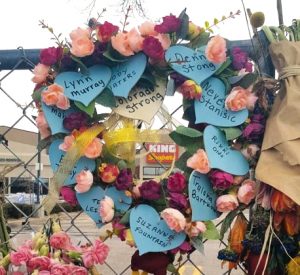Preserving, Healing, Remembering
14 Jun 2021
After the tragic shooting in Boulder in March, local community members and far-flung visitors congregated at the chain-link fence in front of King Soopers to leave flowers, notes, artwork and other items commemorating the lives we lost to a devastating act of violence. Together, the objects placed at the memorial create a snapshot of Boulder’s love, grief, compassion and pain during a horrifying time in local history. As such, they deserve preservation and care.
Organizers with the Museum of Boulder have taken that responsibility on; staff members and volunteers have been collecting items so they won’t get destroyed by the elements. The museum’s curator of collections, Chelsea Pennington Hahn, visits the memorial nearly every day to gather items for preservation (after they’ve been there for a week or more). “The memorial at the fence is such a unique outpouring of love, and we think it’s imperative to preserve that as much as we can,” she says. “Many people won’t want to or be able to go to the fence itself—either because they live farther away and can’t travel because of the pandemic, or it might just be too emotional for them.”
Pennington Hahn and the rest of the team have been preserving and cataloging items, but they make a point of clarifying that the artifacts do not belong to the museum. The city of Boulder has partnered with them to discuss how the items will be displayed and available to the community in the future. “Memorial discussions are in the very early stages,” says Lori Preston, the museum’s executive director. “Development of a possibly long-term Boulder Strong Memorial is anticipated to take several years of thoughtful conversation in partnership with the city, the museum and those directly impacted by the tragedy.”
The preservation effort has mostly focused on saving paper-based items like notes, posters and artwork that are most vulnerable to rain or snow. Organic items like flowers cannot be taken into the museum’s collection facility, but local artists have offered to dry the flowers so they can be made into jewelry for victims’ families, or to process them into pigments for paint.
The museum is also reaching out to community members for input on future memorial plans, and for details about mementos left at the memorial sites. The objects alone have profound meaning, but the museum is also working to link them with written memories and sentiments from the individuals and families who brought them to the memorial.
Pennington Hahn says, “The museum wants to respectfully help the community remember the event, but also—more importantly—remember the way we came together as a community to support each other, and to remember and grieve the lives that were taken from us.”
In Loving Memory
Tralona Bartkowiak

Suzanne Fountain
Teri Leiker
Kevin Mahoney
Lynn Murray
Rikki Olds
Neven Stanisic
Denny Stong
Eric Talley
Jody Waters
To learn more about preservation efforts, visit museumofboulder.org/community. To share your own story about an item left at the memorial, visit bit.ly/3sqfnUp.












